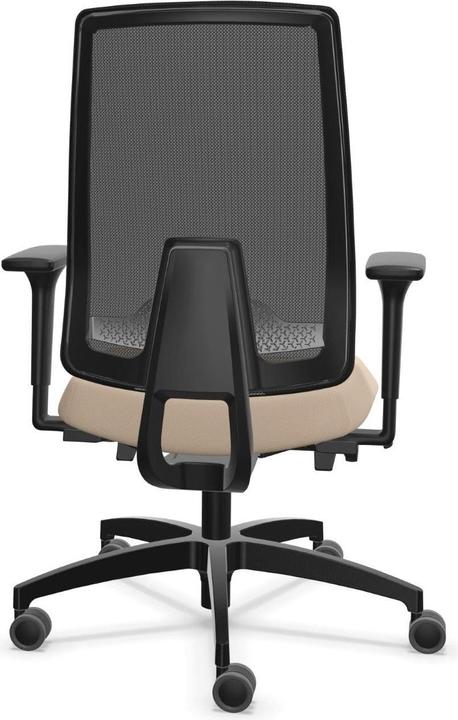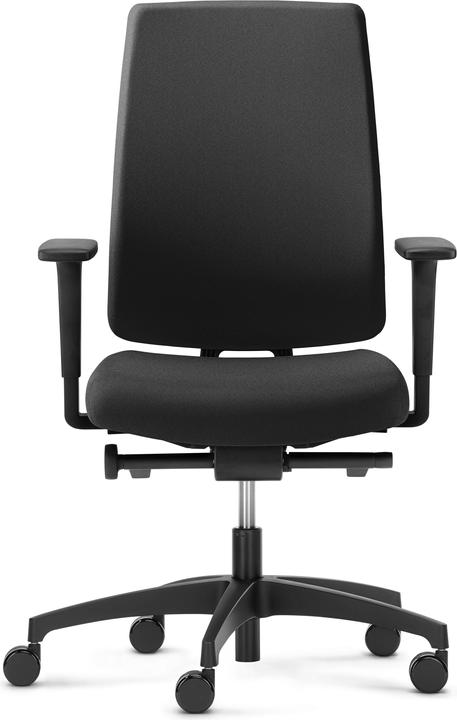

I’m incredibly comfortable on the Dauphin Indeed, but it hasn’t made me lazy
Even an office chair that costs well under 1,000 francs has everything I want for my home office. I’m also impressed by the Dauphin Indeed’s sustainable credentials and its incredibly comfortable seat cushion.
Ever since my colleague Pia sang the praises of the Hag Capisco in her review, it’s been the office chair of my dreams. But the price – well over 1,000 francs or euros – really puts me off.
When looking for alternatives, I’m looking in the mid-range segment. The Indeed by Dauphin aims to be exactly that: a good chair, properly designed and reasonably priced, and sustainable too. But does it achieve it?
Dauphin had a chair delivered to my home via a shipping company. It comes enrobed in plastic sheets, but it’s already assembled. I don’t want to know how Dauphin saves 60 per cent on its packaging volume, as stated on the website. That’s what supposedly makes Indeed particularly sustainable. If a chair takes up less space in the truck, more can fit in it, so fewer trips are necessary. This ultimately saves CO₂.
Sustainable from start to finish
The Indeed’s fabric is intended to reduce its carbon footprint even further. It’s woven from polyester yarn, whose raw material is recycled PET bottles.
Just as importantly, Dauphin doesn’t just think about the environment during production. If the Indeed ever comes to the end of its life, waste disposal companies will be happy. All parts of the chair that are heavier than 50 grammes are labelled and sorted, making them easy to recycle. You’ll almost certainly enjoy this chair for a very long time, because wear and tear elements can be reordered and replaced. The upholstery can also be replaced as one piece if it wears.
Next-level seating comfort
Speaking of cushions, my eco-conscience is happy about the Indeed’s sustainable credentials. My bum, on the other hand, enjoys the incredibly comfortable seat. I noticed the cushion at first glance. It’s a little thicker. But this isn’t simply due to slightly more or higher foamed plastic. This is a «performance seat with micro pocket spring cores», at least that’s what it’s called in marketing speak. In plain English, you could say that Dauphin has reduced the size of the pocket spring cores we recognise from mattresses and built them into the Indeed. The seat is basically a mini box spring bed.

Source: Dauphin
This design actually takes my sitting experience to a new level. Admittedly, that also sounds like marketing blurb. But since my role as an editor means that I test independently of the manufacturer’s interests, you can definitely believe me.
The pocket spring cores ensure that my body weight is well distributed and there are no pressure points. The underside of the thighs towards the knees is usually a particularly problematic area. The Indeed avoids this by making the seat from a total of seven layers:
- the lower plastic shell,
- the layer with a total of 48 pocket spring cores,
- a layer of fleece around it,
- dimensionally stable polyurethane foam,
- viscoelastic foam (for a mattress, this would be the topper),
- a layer of cotton wool and
- the fabric of the seat cover.
All of this creates a structure that’s around eight centimetres high.
Plenty of functions for healthy sitting
I’m glad someone thought about building the seat for me. This gives me the time I need to take care of the many setting options. With the maximum configuration, I can adjust nine parameters on the Indeed to suit my body type and preferences. After a bit of pulling, pushing and twisting, I gave up trying to get my head around all the functions without help. I needed the instructions. I also watched the YouTube video, which was a bit annoying but helpful.
Seat height
This is still the easiest to adjust. The lever on the front right under the seat activates the gas spring and lets me freely choose a seat height between 40 and 52 centimetres. The highest setting, has me (I’m about 1.91 metres tall) sitting exactly as recommended in specialist literature, i.e. with my knees at 90 degrees or more when my feet are flat on the floor. Anyone taller will be less likely to get on with the Indeed.
Seat depth
Indeed’s seat depth adjustment is perfectly tailored to the needs of people with long thighs. By pressing the lever under the seat, I can move the padded seat horizontally up to a total of eight centimetres. In the furthest forward position, I have enough contact surface for my thighs towards my knees. The rule of thumb here is that the distance between the front edge of the seat and the back of the knee should be at least two finger widths and at most one hand width.
Backrest and lumbar support
My test chair has lumbar support built into the backrest. Ideally, the support for my lumbar area would be at belt height, but I can’t adjust the height of the lumbar support separately on the Indeed. That’s why the height adjustment of the backrest – it ranges from 61 to 68 centimetres – always defines the position of the lumbar support. This is a small limitation in everyday life. I’d like the backrest to be a little higher, but then that makes the lumbar support too high.
If I turn the plastic wheel that controls the level of support, I can partially compensate for that. However, I can never remember whether I have to turn clockwise or anticlockwise.

Source: Martin Jungfer
Seat tilt
To ensure that finding the right lever remains a challenge, the Indeed also has one for tilting the seat. I can either sit completely flat or tilt the seat forward up to four degrees – this is called active sitting because it requires my leg muscles to support me.

Source: Martin Jungfer
Dynamic sitting
Anyone who didn’t sit as still as possible at school soon earned a reputation as a fidget. Today, we know that frequent changes in position are good. Indeed supports me to do this. The backrest gives me counter pressure, the degree of which I can adjust. The whole thing is called Syncro-Evolution and is controlled via a small wheel under the seat – one of seven (!) controls down there. If I don’t need any pressure on my back, I can also lock the wheel. The backrest is then fixed in one of four positions – from upright to the relaxation setting with a 128-degree angle between seat and backrest.

Source: Martin Jungfer
Headrest and armrest
I can adjust the armrests of the Indeed in two directions. I can push them out from the seat if the 46 centimetres of internal width are too restrictive, and I can adjust the height to be orthopaedically correct. This means that my arms form a right angle at the elbow when they’re resting.
Verdict
The Indeed ends my search for a decent chair for my home office – at least for now. It showed me that I need a very comfortable seat. The Capisco with its horse saddle shape now seems significantly less attractive to me. My muscles would certainly have to work harder on the Capisco. But the Indeed has numerous adjustment options and the Synchro mechanism stops me becoming lazy.
I haven’t even mentioned the design so far, as it’s ultimately a matter of taste. And only few people are impressed by design awards that the Indeed has already won. I think it’s more important that the chair is well made. The plastics feel pleasant, particularly the surfaces of the armrests. Even dark jeans couldn’t harm the water blue fabric on the seat cushion. Even after several weeks of intensive use, there’s no discoloration and no trace of rubbing.
Good durability is also key to being more sustainable. If being «green» is as comfortable as the Indeed, then I’ve found my happy place.

Source: Martin Jungfer
Do you have any questions about the Indeed? Would you like to know anything that’s missing from the test report? Let me know in the comments below and I’ll be happy to help.
Header image: Martin JungferJournalist since 1997. Stopovers in Franconia (or the Franken region), Lake Constance, Obwalden, Nidwalden and Zurich. Father since 2014. Expert in editorial organisation and motivation. Focus on sustainability, home office tools, beautiful things for the home, creative toys and sports equipment.





